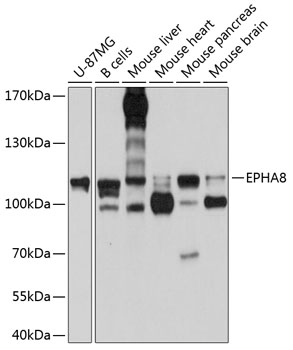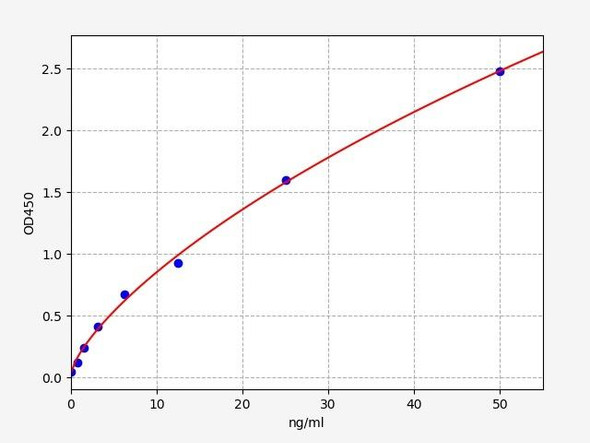Cell Biology Antibodies 1
Anti-EPHA8 Antibody (CAB10213)
- SKU:
- CAB10213
- Product Type:
- Antibody
- Reactivity:
- Human
- Reactivity:
- Mouse
- Host Species:
- Rabbit
- Isotype:
- IgG
- Antibody Type:
- Polyclonal Antibody
- Research Area:
- Cell Biology
Description
| Antibody Name: | Anti-EPHA8 Antibody |
| Antibody SKU: | CAB10213 |
| Antibody Size: | 20uL, 50uL, 100uL |
| Application: | WB |
| Reactivity: | Human, Mouse |
| Host Species: | Rabbit |
| Immunogen: | Recombinant fusion protein containing a sequence corresponding to amino acids 28-300 of human EPHA8 (NP_001006944.1). |
| Application: | WB |
| Recommended Dilution: | WB 1:1000 - 1:2000 |
| Reactivity: | Human, Mouse |
| Positive Samples: | U-87MG, B cells, Mouse liver, Mouse heart, Mouse pancreas, Mouse brain |
| Immunogen: | Recombinant fusion protein containing a sequence corresponding to amino acids 28-300 of human EPHA8 (NP_001006944.1). |
| Purification Method: | Affinity purification |
| Storage Buffer: | Store at -20'C. Avoid freeze / thaw cycles. Buffer: PBS with 0.02% sodium azide, 50% glycerol, pH7.3. |
| Isotype: | IgG |
| Sequence: | ARGE VNLL DTST IHGD WGWL TYPA HGWD SINE VDES FQPI HTYQ VCNV MSPN QNNW LRTS WVPR DGAR RVYA EIKF TLRD CNSM PGVL GTCK ETFN LYYL ESDR DLGA STQE SQFL KIDT IAAD ESFT GADL GVRR LKLN TEVR SVGP LSKR GFYL AFQD IGAC LAIL SLRI YYKK CPAM VRNL AAFS EAVT GADS SSLV EVRG QCVR HSEE RDTP KMYC SAEG EWLV PIGK CVCS AGYE ERRD ACVA CELG FYKS APGD QLCA RCPP HSHS A |
| Gene ID: | 2046 |
| Uniprot: | P29322 |
| Cellular Location: | Cell membrane, Cell projection, Early endosome membrane, Single-pass type I membrane protein |
| Calculated MW: | 53kDa/111kDa |
| Observed MW: | 111kDa |
| Synonyms: | EPHA8, EEK, EK3, HEK3 |
| Background: | This gene encodes a member of the ephrin receptor subfamily of the protein-tyrosine kinase family. EPH and EPH-related receptors have been implicated in mediating developmental events, particularly in the nervous system. Receptors in the EPH subfamily typically have a single kinase domain and an extracellular region containing a Cys-rich domain and 2 fibronectin type III repeats. The ephrin receptors are divided into 2 groups based on the similarity of their extracellular domain sequences and their affinities for binding ephrin-A and ephrin-B ligands. The protein encoded by this gene functions as a receptor for ephrin A2, A3 and A5 and plays a role in short-range contact-mediated axonal guidance during development of the mammalian nervous system. |
| UniProt Protein Function: | EphA8: a receptor tyrosine kinase of the Eph family. A receptor for members of the ephrin-A family: ephrin A2, A3 and A5. Plays a role in short-range contact-mediated axonal guidance during development of the mammalian nervous system. The Eph receptor tyrosine kinase family, the largest in the tyrosine kinase group, has fourteen members. They bind membrane-anchored ligands, ephrins, at sites of cell-cell contact, regulating the repulsion and adhesion of cells that underlie the establishment, maintenance, and remodeling of patterns of cellular organization. Eph signals are particularly important in regulating cell adhesion and cell migration during development, axon guidance, homeostasis and disease. EphA receptors bind to GPI-anchored ephrin-A ligands, while EphB receptors bind to ephrin-B proteins that have a transmembrane and cytoplasmic domain. Interactions between EphB receptor kinases and ephrin-B proteins transduce signals bidirectionally, signaling to both interacting cell types. Eph receptors and ephrins also regulate the adhesion of endothelial cells and are required for the remodeling of blood vessels. Contains 1 sterile alpha motif (SAM) domain and 2 fibronectin type III domains. |
| UniProt Protein Details: | Protein type:EC 2.7.10.1; Eph family; Kinase, protein; Membrane protein, integral; Protein kinase, TK; Protein kinase, tyrosine (receptor); TK group Chromosomal Location of Human Ortholog: 1p36.12 Cellular Component: integral to plasma membrane; neuron projection; plasma membrane Molecular Function:GPI-linked ephrin receptor activity Biological Process: axon guidance; ephrin receptor signaling pathway; neurite development; neuron remodeling; positive regulation of MAPKKK cascade; positive regulation of phosphoinositide 3-kinase activity; protein amino acid autophosphorylation; regulation of cell adhesion; regulation of cell adhesion mediated by integrin; substrate-bound cell migration |
| NCBI Summary: | This gene encodes a member of the ephrin receptor subfamily of the protein-tyrosine kinase family. EPH and EPH-related receptors have been implicated in mediating developmental events, particularly in the nervous system. Receptors in the EPH subfamily typically have a single kinase domain and an extracellular region containing a Cys-rich domain and 2 fibronectin type III repeats. The ephrin receptors are divided into 2 groups based on the similarity of their extracellular domain sequences and their affinities for binding ephrin-A and ephrin-B ligands. The protein encoded by this gene functions as a receptor for ephrin A2, A3 and A5 and plays a role in short-range contact-mediated axonal guidance during development of the mammalian nervous system. [provided by RefSeq, Jul 2008] |
| UniProt Code: | P29322 |
| NCBI GenInfo Identifier: | 19857975 |
| NCBI Gene ID: | 2046 |
| NCBI Accession: | P29322.2 |
| UniProt Secondary Accession: | P29322,Q6IN80, Q8IUX6, Q9NUA9, Q9P269, |
| UniProt Related Accession: | P29322 |
| Molecular Weight: | 111kDa |
| NCBI Full Name: | Ephrin type-A receptor 8 |
| NCBI Synonym Full Names: | EPH receptor A8 |
| NCBI Official Symbol: | EPHA8 |
| NCBI Official Synonym Symbols: | EEK; EK3; HEK3 |
| NCBI Protein Information: | ephrin type-A receptor 8 |
| UniProt Protein Name: | Ephrin type-A receptor 8 |
| UniProt Synonym Protein Names: | EPH- and ELK-related kinase; EPH-like kinase 3; EK3; hEK3; Tyrosine-protein kinase receptor EEK |
| Protein Family: | Ephrin type-A receptor |
| UniProt Gene Name: | EPHA8 |
View AllClose







